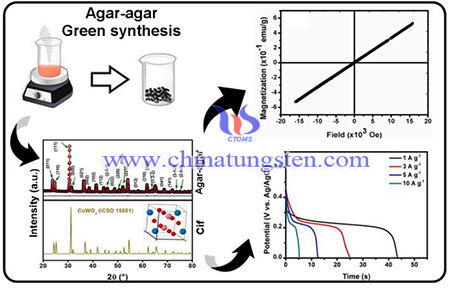Preparation of Cobalt Tungstate Powders Applying APT and Agar-Agar from Red Seaweed
- Details
- Category: Tungsten Information
- Published on Friday, 09 July 2021 05:29
Cobalt tungstate (CoWO4) with monoclinic wolframite structure has been used in a wide range of potential applications including supercapacitors, photocatalysts, catalyst for oxygen evolution reaction (OER) and hydrogen production, microwave dielectric ceramics, photovoltaic electrochemical cells, among others. As electrochemical energy storage devices, batteries and supercapacitors have attracted significant attention due to their intrinsic characteristics of energy and power densities, cycling stabilities and charging-discharging rates.
Agar-agar is a denatured collagen protein extracted from red algae of the class Rhodophyceae that has been widely used in pharmaceutical and food industries. Cobalt tungstate powders were successfully obtained by a green synthesis method that use agar-agar from red seaweed and ammonium paratungstate (APT), it is a potential material for battery-like electrodes.

The synthesis process of cobalt tungstate powder retrieved from APT and red seaweed is as below: Ammonium paratungstate (APT), cobalt nitrate hexahydrate (Co(NO3)2.6H2O, 99%), agar-agar, and flavorless gelatin were employed as raw materials.
Firstly, 2.0 g of the polymerizing agent (agar-agar or gelatin) was dispersed in 50 ml of distilled water at 50 °C. Then, stoichiometric amounts of the cation precursors were added and the resulting solutions were kept under stirring at 80 °C until the formation of a gel. The resins were heat treated at 250 °C for 1 h to eliminate excess of water and volatile organic compounds. The resulting powders were crushed and annealed again at 800 °C for 2 h in air.

The resulting powders were crushed and annealed again at 800 °C for 2 h in air. The X-ray diffraction (XRD) technique was used to characterize the crystal structure. XRD data were collected using a Rigaku Miniflex II equipment within the angular range of 20–90° (2θ) at a speed of 2°/minute and a 0.02° step. Quantitative phase analysis and determination of lattice parameter/crystallite size were performed by Rietveld refinement analysis using TOPAS program. The particle size distribution was carried out by analyzing scanning electron microscopy images obtained by field emission scanning electron microscopy-FESEM (ZEISS AURIGA).
In conclusion, Cobalt tungstate powders were successfully obtained by a green synthesis method that use agar-agar from red seaweed and APT. The long-term stability of electrodes is confirmed by a capacity retention of around 98% over 1000 charge-discharge cycles at a specific current of 1 A g−1. Therefore, CoWO4 powders synthesized using agar-agar and gelatin are promising materials for battery-like electrodes.
- APT Manufacturer & Supplier, Chinatungsten Online: ammonium-paratungstate.com
- Tungsten News & Prices of China Tungsten Industry Association: www.ctia.com.cn
- Molybdenum News & Price: news.molybdenum.com.cn
- Tel.: 86 592 5129696; Fax: 86 592 5129797; Email: sales@chinatungsten.com



 sales@chinatungsten.com
sales@chinatungsten.com